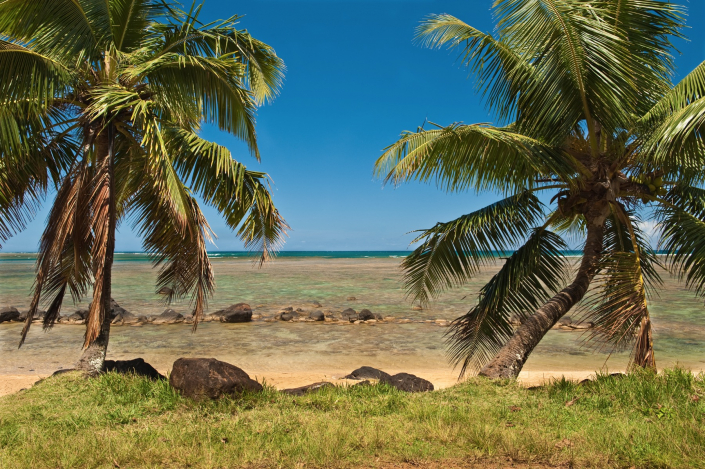Anini Beach is one of the most popular locations for snorkeling and family-friendly beach days. Thanks to one of the largest shallow fringing reef systems in the state, Anini Beach is moderately protected from large ocean swells and strong currents. This fragile reef is also responsible for a host of sea life, including diverse fish species, honu (green sea turtles) and the common state fish, humuhumunukunukuapua’a!
Unfortunately, we have seen a dramatic decline in coral reef health at Anini Beach during the past decade. Influences such as toxic sunscreen, pesticide runoff and human contact have directly impacted the coral’s vibrancy. Since it is the coral that attracts sea life, there has also been a decline in diversity.
Alas! There is no need to fret. While the decline is dismaying, there are simple choices you can make to help restore balance, and there’s still a world of fun to be had at this incredible beach!
About Anini Beach
Spanning nearly two miles long, Anini Beach is a maritime playground for myriad activities. The shallow waters and gradual grade make it perfect for keiki (kids). Mellow currents and wave-protection from the reef offer a lagoon-like experience for paddle boarding. And, despite the coral reef decline, there is still beauty to behold in the eye of the snorkeler!
With two miles of beach and reef, there is something at Anini for everyone. Long beach strolls, seashell combing, gentle treading or active swimming, snorkeling, paddle boarding, or just lounging are all possibilities!
Public restrooms and outdoor showers are centrally located at the Beach Park for your convenience. There are also covered pavilions for day use. If you’re craving something more earthy, however, dappled shade can be procured along the whole coastline, thanks to old growth kamani trees (Indian Almond).

3 Ways To Help Restore The Reef
By all means, we welcome you to enjoy your time and soak up the mana (innate life force) at beautiful Anini Beach. By making these three simple choices, you can also help restore the fragile coral reef to full vitality! We’ve seen it happen on the North Shore, so we know it can happen here too!
1 – Use Reef Safe Sunscreen
In 2018 the State of Hawaii passed a law prohibiting toxic sunscreen to be sold statewide. This was after studies proved common chemical sunscreen ingredients, such as oxybenzone and octinoxate, can kill coral and damage coral reefs. Unfortunately, this sanction does not go into effect until 2020. So, in the meantime, you can do your part by purchasing and using Reef Safe Sunscreen! Buy online before arriving or find Reef Safe Sunscreen available islandwide.
On that note, experts say to apply sunscreen at least 20 minutes before getting in the water. This is the amount of time it takes to set on your skin so it doesn’t come off in the water.
Tip: when buying Reef Safe Sunscreen, make sure the ingredients are biodegradable.
2 – Refrain from Physical Contact with the Coral
It has also been proven that the oils from our skin can disturb this delicate microcosm. Touching coral reef actually harms the living coral polyps that manufacture reef structure. So, in an effort to respect and preserve, please admire the beauty of coral from a distance and refrain from standing on our touching the reef when possible.
3 – Avoid Plastics When Possible
A leading cause to oceanic imbalance is accumulating microplastics. We all know the story. So let’s do our part. And remember, Kauai is an isolated and fragile ecosystem in the middle of the Pacific Ocean, so every tiny choice can make a big difference.
Thank you for your help in keeping Anini Beach and its coral reef beautiful!

